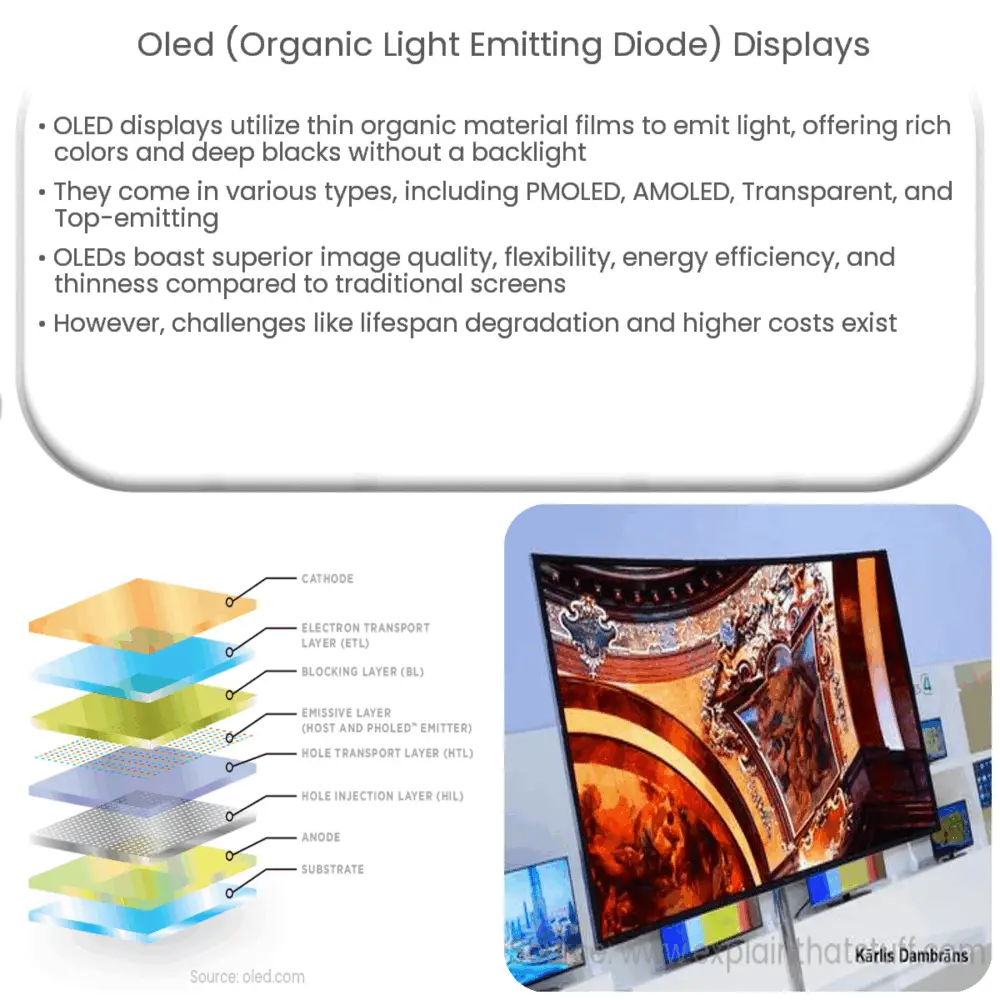Explore the revolutionary world of OLED display technology, its types, working principles, advantages, limitations, and its promising future.

OLED (Organic Light Emitting Diode) Displays
The world of visual technology is continuously evolving, and one such leap forward is in the development of OLED technology. OLED stands for Organic Light Emitting Diode, and it is a type of display technology that makes rich, vibrant colors and truly deep blacks possible in digital screens.
What is an OLED Display?
An OLED display is a type of digital display that employs a thin organic material film between two conductors that emits light when an electric current is applied. Unlike LCDs or regular LED screens, OLED displays do not require a backlight. The organic molecules emit light when electricity is applied, and the intensity of the light can be controlled on a per-pixel level. This provides an exceptional level of control over image quality, color accuracy, and contrast ratios, leading to stunning visual experience.
Types of OLED Displays
- PMOLED: Passive Matrix OLEDs are one of the most common types. They are relatively inexpensive and easy to produce, but they are not as efficient or long-lasting as other types. PMOLEDs are often used in smaller screens such as those in wearable devices or small appliances.
- AMOLED: Active Matrix OLEDs are more complex and expensive to manufacture but offer better image quality, longer lifespan, and are more efficient. AMOLEDs are used in high-end televisions, smartphones, and tablets.
- Transparent OLED: This type of OLED is transparent when turned off, providing the possibility of entirely new types of displays and applications.
- Top-emitting OLED: This OLED has a substrate that is not transparent but uses a top-emitting panel to enable the light to escape. This type is used when the substrate material is too robust or rigid to allow for a transparent or bottom-emitting design.
The Working Principle of OLEDs
The basic working principle of an OLED involves applying electric current to the organic layers sandwiched between the cathode and anode. When an electric current is applied, electrons from the cathode and ‘holes’ from the anode are injected into the organic layers. Here, they recombine to form ‘excitons’—a state where an electron is excited but bound to a hole. When these excitons relax, they emit light, which escapes through the substrate layer. This entire process is called ‘electrophosphorescence.’
Advantages of OLED Displays
There are numerous advantages that OLED displays offer over traditional LCD or LED screens. Here are some of the key benefits:
- Superior Image Quality: OLEDs provide much better picture quality with high contrast ratios, a wider viewing angle, and a faster refresh rate. This leads to smooth images with rich colors, deep blacks, and excellent detail.
- Flexibility: OLEDs can be made flexible, allowing for the creation of curved or bendable displays. This is a significant advantage in the evolving world of wearable technology and innovative gadget design.
- Energy Efficiency: OLEDs are more energy-efficient as they do not require a backlight. Each pixel generates its own light, which means the screen only uses power for the pixels that are lit up. Dark or black pixels use no energy.
- Thinness: As OLEDs do not require a backlight, they can be incredibly thin. This leads to sleeker device designs and lighter gadgets.
Limitations of OLED Displays
Despite the many advantages, there are also a few limitations associated with OLED technology:
- Lifespan: The organic materials in OLEDs degrade over time, which can lead to color balance issues as different colors degrade at different rates.
- Cost: The manufacturing process of OLEDs is currently more expensive than that of LCDs, which can make devices using OLED technology more costly.
Conclusion
In conclusion, OLED technology, with its many advantages, is leading the way in the evolution of display technologies. The superior image quality, flexibility, energy efficiency, and thinness of OLEDs make them a highly desirable choice for many devices, from smartphones and tablets to televisions and wearables.
However, there are also challenges to be overcome, particularly around lifespan and cost. As research and development continue in this area, we can expect to see further improvements and potentially new applications of OLED technology. Despite the hurdles, the future of OLED technology looks promising, and it is set to redefine our visual experience in the years to come.

